Abstract
For a class of linear constant-coefficient finite-difference operators of the second order, we introduce the concepts similar to those of conventional single- and double-layer potentials for differential operators. The discrete potentials are defined completely independently of any notion related to the approximation of the continuous potentials on the grid. We rather use an approach based on differentiating, and then inverting the differentiation of, a function with surface discontinuity of a particular kind, which is the most general way of introducing surface potentials in the theory of distributions. The resulting finite-difference “surface” potentials appear to be solutions of the corresponding system of linear algebraic equations driven by special source terms. The properties of the discrete potentials in many respects resemble those of the corresponding continuous potentials. Primarily, this pertains to the possibility of representing a given solution to the homogeneous equation on the domain as a variety of surface potentials with the density defined on the domain's boundary. At the same time, the discrete surface potentials can be interpreted as one specific realization of the generalized potentials of Calderon's type, and consequently, their approximation properties can be studied independently in the framework of the difference potentials method by Ryaben'kii. The motivation for introducing and analyzing the discrete surface potentials was provided by the problems of active shielding and control of sound, in which the aforementioned source terms that drive the potentials are interpreted as the acoustic control sources that cancel out the unwanted noise on a predetermined region of interest.
Similar content being viewed by others
References
Calderon, A. P. (1963). Boundary-value problems for elliptic equations. In Proceedings of the Soviet-American Conference on Partial Differential Equations at Novosibirsk, Moscow, Fizmatgiz, pp. 303-304.
Kamenetskii, D. S. (1995). The Method of Difference Potentials: Certain Problems of Modified Calderon Potentials, Parts I–III, Technical Report 94–96, Keldysh Institute of Applied Mathematics, Russian Academy of Sciences, Moscow, (In Russian).
Kamenetskii, D. S. (1998). Difference potentials and the parameterization of solutions of homogeneous difference equations. Comput. Math. Math. Phys. 38(11), 1754-1767.
Kamenetskii, D. S. (1999). Difference generalized Poincaré-Steklov operators and potentials with density from a space of jumps. Comput. Math. Math. Phys. 39(8), 1275-1282.
Kamenetskii, D. S. (2000). On one form of representing the difference potentials. Appl. Numer. Math. 33(1–4), 501-508.
Lončariâc, J., Ryaben'kii, V. S., and Tsynkov, S. V. (2001). Active shielding and control of noise. SIAM J. Appl. Math. 62(2), 563-596.
Lončariâc, J., and Tsynkov, S. V. (2002a). Quadratic optimization in the problems of active control of sound. Technical Report 2002-35, NASA/CR-2002-211939, ICASE, Hampton, VA, October 2002;-submitted to SIAM J. Appl. Math..
Lončariâc, J., and Tsynkov, S. V. (2002b). Optimization of acoustic source strength in the problems of active noise control. SIAM J. Appl. Math., to appear;-also Technical Report 2002-11, NASA/CR-2002-211636, ICASE, Hampton, VA, May 2002.
Nelson, P. A., and Elliot, S. J. (1999). Active Control of Sound, San Diego, Academic Press.
Proskurowski, W., and Widlund, O. (1976). On the numerical solution of Helmholtz's equation by the capacitance matrix method. Math. Comp. 30, 433-468.
Ryaben'kii, V. S. (1971). The method of internal boundary conditions in the theory of boundary value difference problems. Russian Math. Surveys 26, 117-176
Ryaben'kii, V. S. (1985). Boundary equations with projections. Russian Math. Surveys 40, 147-183.
Ryaben'kii, V. S. (1987). Difference Potentials Method for Some Problems of Continuous Media Mechanics, Moscow, Nauka. In Russian.
Ryaben'kii, V. S. (1995). A difference screening problem, Funct. Anal. Appl. 29, 70-71.
Ryaben'kii, V. S. (1998). A Nonlinear Difference Shielding Problem. In Bach, M., Constanda, C., Hsiao, G. C., Sändig, AM., and Werner, P. (eds.), Analysis, Numerics, and Applications of Differential and Integral Equations, Longman, Harlow, pp. 179-182
Ryaben'kii, V. S. (2002). Method of Difference Potentials and Its Applications, Berlin, Springer-Verlag.
Seeley, R. T. (1966). Singular integrals and boundary value problems. Amer. J. Math. 88, 781-809.
Tikhonov, A. N., and Samarskii, A. A. (1963). Equations of Mathematical Physics, Oxford, Pergamon Press.
Veizman, R. I., and Ryaben'kii, V. S. (1997a). Difference problems of screening and simulation. Dokl. Akad. Nauk 354, 151-154.
Veizman, R. I., and Ryaben'kii, V. S. (1997b). Difference simulation problems. In Transactions of Moscow Mathematics Society, pp. 239-248.
Vladimirov, V. S. (1971). Equations of Mathematical Physics, New-York, Dekker-
Author information
Authors and Affiliations
Rights and permissions
About this article
Cite this article
Tsynkov, S.V. On the Definition of Surface Potentials for Finite-Difference Operators. Journal of Scientific Computing 18, 155–189 (2003). https://doi.org/10.1023/A:1021111713715
Issue Date:
DOI: https://doi.org/10.1023/A:1021111713715
- linear differential operator
- discontinuous solution
- distribution
- monopole
- dipole
- fundamental solution
- convolution
- boundary integral
- single- and double-layer potentials
- surface density of the potential
- linear difference operator
- multi-layer grid boundary, discontinuous grid function
- discrete monopole and dipole layers
- Calderon's potential
- difference potential




